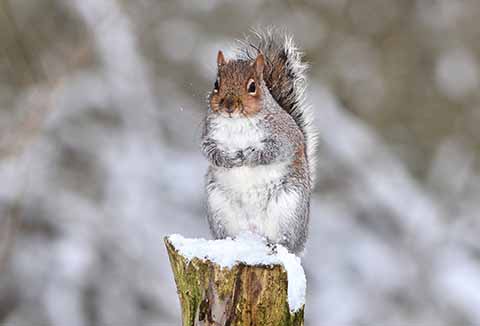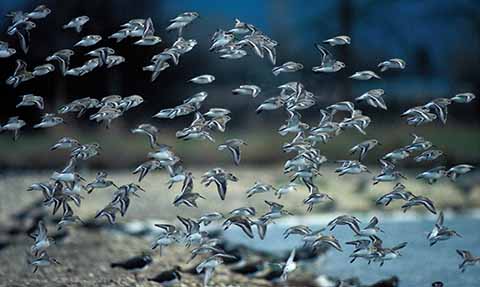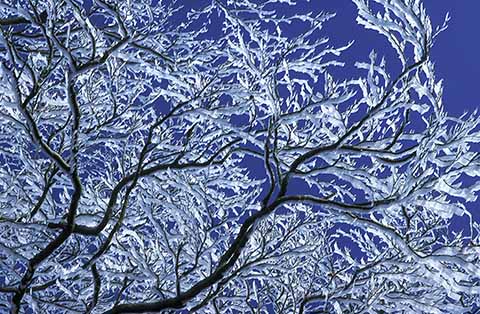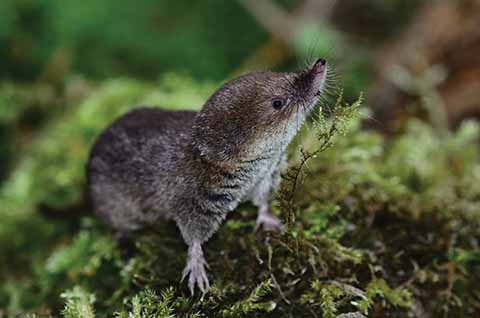Colin Varndell’s Dorset seasons. Winter: January in Dorset
Colin looks at the struggle for survival for nature at its harshest moment
Published in January ’19
Weather is the most crucial factor for wildlife this month. January is the time when we can expect plummeting temperatures, unforgiving hard frosts, or at worst a blanket of snow. The state of the weather now can spell survival or death for many wild creatures.
We are more likely to experience frost than snow, with frost forming when the air temperature falls below freezing, so that water vapour forms ice crystals. The two types of this weather condition we most often see are hoar frost and rime frost, the former being the most likely. Hoar frost has a feathery appearance and is the frost we most often encounter on the ground and on low vegetation. Often, frost occurring on trees is incorrectly referred to as hoar frost but this is in fact rime frost. Rime frost occurs when very humid, foggy and cold conditions are coupled with a slight breeze. The wind blowing through the mist results in ice crystals building up on vertical features like trees. Unlike hoar frost, rime frost has a solid appearance, with blades of ice forming on the side of vertical features facing the wind direction.

Contrary to popular belief, grey squirrels do not hibernate, but are active even in the coldest conditions
At this time of year with short days and long, cold nights, the challenge for wildlife to survive becomes more desperate, with a scarcity of food and little time to find it. Some birds like wrens, for example, need to eat the equivalent of their own bodyweight each day to survive. In fact, apart from brief spells of bathing and preening, most small birds spend all of the daylight hours feeding. They need to find and consume enough food to keep their energy levels up to sustain them through the following night.
Wild creatures adopt various strategies for coping with the difficulties that winter brings. Some hibernate, others spend winter as an egg or pupa, while others simply fly away to warmer climates.
While many bird species which bred here during the summer have now flown away, other birds actually arrive to spend the winter months in Dorset. Wildfowl and wading birds have flown in from the north to take advantage of our warmer climate. Foreign cousins of more familiar birds like starlings and blackbirds join these winter visitors. In some years even waxwings can reach into Dorset by January. These are birds from Scandinavia and have come to Britain in search of fruit, most often found on garden shrubs. If waxwings do arrive in Dorset this month, you would most likely find them on housing estates, where they feed on berry-laden garden shrubs.

Green woodpeckers feed on ant eggs throughout the year, but in frozen conditions turn their attention to turning over leaf litter in search of invertebrates
Most butterflies spend the winter in egg, larva or pupa form. But some over-winter as adult butterflies; these include small tortoiseshell, peacock, comma and brimstone. The latter two have wing shapes which help them to merge into leaf litter or evergreen foliage.
Few of our native mammals actually hibernate: apart from all bats, it is only the hedgehog and dormouse that undertake this dangerous means of living through winter months of famine. These animals choose this way of surviving by storing extra fat reserves in autumn. In hibernation the body temperature is significantly lowered as well as heart rate and breathing, techniques which have evolved to reduce energy consumption.
Shrews are insectivorous and need to feed every two hours, even in the depths of winter. Shrews are very capable of finding invertebrate food, though, and will rummage through moss, decaying wood or leaf litter to fill their stomachs.
In woods and copses, wood mice leave their day nests to scuttle across the forest floor to their store cupboards, which they stocked with nuts in autumn. Patient tawny owls sit motionless on low branches listening for this movement, as it is their only hope for food.
In spite of January being a pretty lifeless time for plants, leaf buds are beginning to swell on native trees and some, like hazel, are already coming into blossom. Hazel catkins are the male flowers, dangling at the ends of twigs and releasing yellow pollen dust to pollinate the tiny crimson female flowers, which will become the hazelnuts of next autumn.
At this midwinter time there are some unique sounds to be heard in the countryside. On cold, clear nights the rasping bark of a female vixen carries far across the frosty landscape. Tawny owls are especially vocal now as they pair up and search for nesting sites, which they will use in a few weeks time. The wispy contact calls of redwings or the cackling laughter of fieldfares are also familiar sounds as flocks of these winter thrushes move between feeding areas.
If the weather is mild towards the end of the month, frogs will begin to stir, driven by the instinct to mate and reproduce. The earliest we have recorded frogs mating in West Dorset was on 13 January.
January may be the coldest month of the year, but the challenges it sets for mammals and birds make it a great time of year for wildlife watching. The snowdrop season will begin before the end of the month to herald in a new period of growth and activity.






